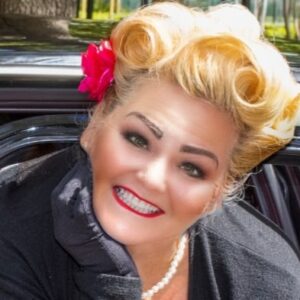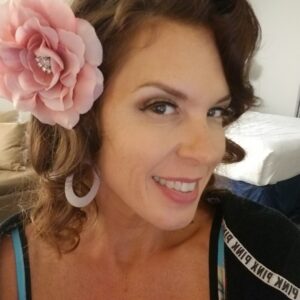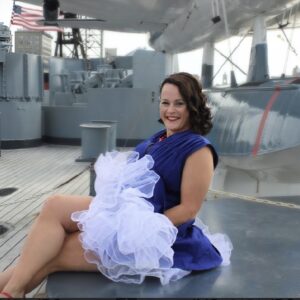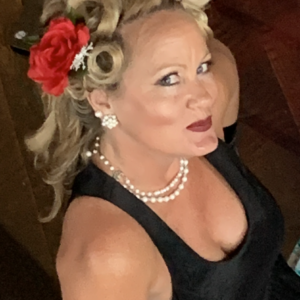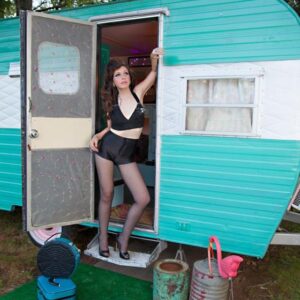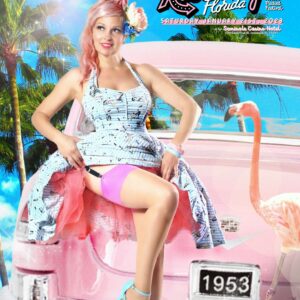Search Pin Up Database
Hi! My friends call me Miss Pink Tink. My nickname comes from the color and singer Pink and my Disney hero Tinkerbell. I like to live life to the fullest no matter how modified... Just keep swimming! I feel my music and play with passion. I have cold hands but a warm heart and I love hard. I love to travel to see new places and recently traveled through the Prarie lands. I enjoy supporting local music, racing go-karts, boxing, martial arts, the beach, car shows and the Pontiac Firebird is my favorite. I'm short and sassy and a little smart assey but most of all I just love being me and enjoying my new pin-up adventure. I have met some beautiful ladies that have supported and have embraced me and all of my curves.. after recently losing 158 pounds and now I look forward to going shopping! BRING ON THE LIPSTICKS AND LASHES! I am looking forward to meeting more of you Ladies and Gents. Squishy hugs, Miss Pink Tink 💗
Hey, all you beauties! I am nurse, a lover of travel, and always out for some fun and adventure. I am known as Miss Stop Your Heart. A nurse by day, and then it's all play; my turn to decide which hearts to resuscitate that I stopped with my pinup lifestyle. Fairly new to the pinup world, late 2021, I have fallen in love with the sisterhood, styles of the era and all around fun it brings. I am a part of Pinup & Pumps and could not ask for a better girl gang to be a part of! Live, Laugh, Love and Pinup!
Ruby Stardust is a Bay Area native and loves all things retro & pinup, spooky/horror movies, and food. Ruby also plays ukulele & often does her own unique spook-ulele covers, rewriting lyrics from popular songs to sing about her favorite horror movies. She recently launched the podcast Pinups & Poltergeists, to discuss all things pinup, retro, spooky and horror related. Ruby is the winner of Miss Cruisin' North Queen 2020 and was featured as a cover model for Retro Lovely Halloween edition, vol. 16. Ruby is also a member of Nor Cal Pinup Girls.
Part of a wonderful small town Pin-up group, who share the same love of pin-ups, classic cars and having fun!
I was raised in the 90's, with Skateboarding, tattoos and Punk Rock music at an early age. I love the ocean, surfing, boating, paddle boarding, fishing snowboarding and collecting shells. I love thrift and vantage shopping, I enjoy the hunt of finding unwanted items and giving them life again. The Pin Up lifestyle feels natural to me.
Pinup * Burlesque // Performer & Producer
Shellie Schmals hearts the arts!! She's a pin up lovin' - microphone holdin' - event hustlin' - dynamo, who can be seen around town mixing up the worlds of film, art, fashion and comedy.
As a talent wrangler and producer/emcee, she's involved in many projects including Roxie Roz burlesque, Small Secret Things, #TheABCDShow; has collaborated as an emcee or worked on stage crew for productions by Syrens of the South, Ariel Allegro, Evangeline Laveau, The FANDom Nerdlesque, Sadie Hawkins, Glitter Goddess Productions, Trashy Diva, Trixie Minx Productions; and is a proud member of the Georgia Pinup Posse and Women in Film & Television Atlanta, where Shellie sits on the Board of Directors as Secretary, coordinates the WIFTA panels at Dragon Con 2020 (Film Track), and co-chairs the annual #WIFTAConfab (short film & talent showcase).
Shellie's column, "My Adventures in Burlesque" debuted in the March 2020 issue of The Georgia Hollywood Review.
As an internationally published pinup, Shellie has been featured in:
* VoyageATL, Art & Life section
* Cat's Pajamas Magazine
* Georgia Pinup Posse Calendar, 2018, 2019, 2020
* Tres' Jolie Magazine
* DeVoe Magazine (Cover Model)
* The Cat's Meow Magazine
* Classy Keen Issue #2
* Girls of Relapse Calendar 2012, 2013
* Vintage Vixens Magazine, Premiere Issue
* The Cat's Meow Magazine: Pre-Furred Pin-up
* Jezebel Magazine: "Street Style" Featured Model
* Atlanta Street Fashion: Featured Model
* Portraits By Shannon Jenkins: Featured Model
* The Cat's Meow Magazine: Featured Pin-Up
* ScoutMob Atlanta: Creative Eye
* CommonCreativ Magazine: 50 Most Creative Atlantans
* ATLRetro.com: Kool Kat of the Week
Hello lovies! Meet Trixie Trixzilla, married mom of three, she serves as secretary of Pinups and Pumps Pennsylvania Chapter. When she's not attending car cruises or participating in pinup contests, she can be found working in the office at the Pennsylvania Hot Rod Company or in the garage getting dirty restoring her 1962 Chevrolet Corvair.
Her hobbies include hiking, camping, collecting vintage glassware and building upon her 10 year philanthropic journey. She has volunteered 3000+ hours and collected over $10K in funds for organizations such as the National Park Service, North Country Trail Association, Village of East Palestine water and donation drives, March of Dimes, Ohio Department of Natural Resources, Patterson Township Parks and St. Barnabas Charities. She loves to give back to the community and hopes she can inspire others to do the same.
Cute and classy, or hot to trot...you never know what Trixie is going to do next!
Pretty Pin Up by Day and professional Burlesque Performer by night!
The Parisian Hostess Pin Up has been living the Pin Up lifestyle for the past 10 years while creating the Handmade Apothecary Brand; The Parisian Hostess, providing Essential Oil products to those that look for a healthier more natural approach to living. Now in its 8th year of business, you can find The Parisian Hostess products in over 40 Boutiques and Spas in the United States. www.TheParisianHostess.com
While she is not creating yummy goodies, she is working professionally as an Emcee of events, Burlesque Class Instructor and empowering woman to feel and look their best!
Editor of the Modern Day Pin Up Magazine - the magazine every Pin Up will be reading! www.ModernDayPinUpMagazine.com
Creator of the Bombshell Academy Bootcamp - where she teaches women how to release their inner Bombshell through hair, makeup, posing and photo shoots.
Owner Glitter Glam Studios- Specializing in Pin Up, Glam and Boudoir Shoots www.glitterglamstudios.com
Television:
TV Norge- Alt for Norge Reality TV Show Season 10: Cast
ESPN- Making the Squad: Miami Dolphins Cheerleader: Cheerleader
American Forces Network- Outside the Gate: Travel Series Host
American Forces Network- Creative Commissary Cooking: Series Host
Bookings:
The Parisian Hostess Pin Up is available for Photoshoots, Hosting & Teaching Engagements. Please send an email for more information.

